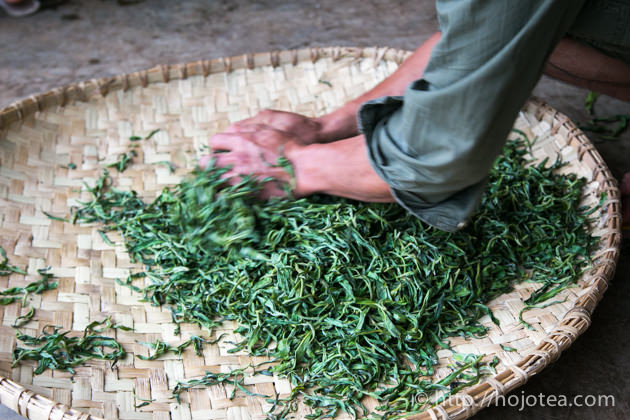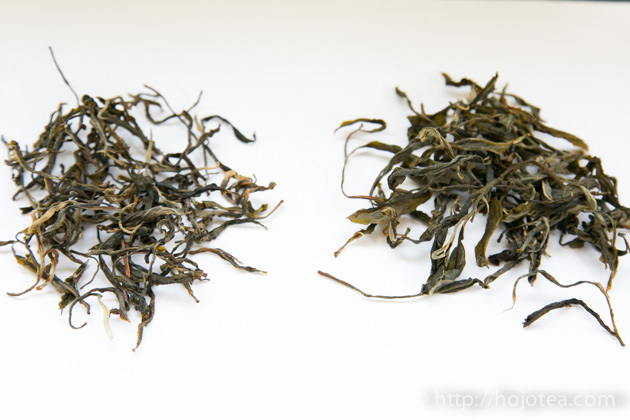- HOME >
- Tea Processing
Do you prefer tea leaf to be rolled tighter or softer?

In making teas, most of the teas will undergo rolling process, except some white tea and green tea. The rolling means rubbing or crumpling the tealeaf. Some tea manufacturers use machine to roll the tealeaf, while some people use their hands to roll. I would like to explain the purpose of rolling, and how the intensity of rolling affects the tea.

The purpose of rolling
The purpose of rolling is to macerate the cells of tealeaf. Due to the micro- scratch, the constituents inside the tealeaf can be easily being extracted during brewing. Usually, it is important as of fermented tea. The fermentation is the oxidation occurred among the enzyme and various kinds of substrate such as poly phenol. The rolling process brings out these substance and initiates inter-reaction.
It is important to understand the effect of rolling in brewing
There are many different types of rolling method. From my point of view, the most important factor is to manage the intensity of rolling. In particular, we need to decide if the tea should be rolled tightly or softly. In this year, we were managing most of the Yunnan teas according to our own processing parameters. In addition to the plucking standard, frying method and drying method, the rolling process is one of the very important parameters. If tealeaf is rolled more intensively, tea leaf becomes tighter and the appearance is more consistent. The mild rolling may result tealeaf to be more bulky and the appearance becomes inconsistent. However, to me, the appearance is not important. The more importantly we need to understand the outcome of brewing tea.
The relationship between rolling and brewing
The rolling affects the speed of extraction. The harder the tealeaf is rolled, the constituents of tea will be extracted quicker. With hard rolling, the taste and flavor is rushing out in the first brewing. The disadvantage of hard rolling is that the brewing does not last. If the quality of tea is good, I favor a milder rolling of tealeaf. Generally, I prefer that the flavor and taste is gradually being extracted and the brewing can lasts for many rounds. Usually, we apply this theory in making our puerh tea.
The taste of Japanese tea comes out too quick due to the intensive rolling
In making Japanese tea, the manufacturer persist the needle shape of tealeaf. Somehow, it is a common Japanese culture that cares a lot on appearance. To make tea into needle shape, tealeaf has to undergo very intensive reciprocal rolling process. Due to the intensive rolling, the taste and flavor of Japanese tea comes out a little too quickly. The taste is fading out pretty fast from the second brewing onwards. I think it is interesting if we can create a Japanese green tea with mild rolling method. It makes the speed of extraction slower, and we may enjoy the taste and flavor over many brewing. I am hoping to run this experiment in this year.
Related Articles
How to get the latest update on HOJO?
1. Follow Twitter, 2. Click "Like" on Facebook, and 3. Subscribe in newsletter. You can have the latest tea news from HOJO.
 Subscribe the Newsletter to enjoy the privileges
Subscribe the Newsletter to enjoy the privileges- You may receive a free sample upon purchase, or you may have the priority to purchase special products. So please remember to subscribe our newsletter as well as the social network.
- Myanmar White Tea Bud 2013 from Guo Gan, Myanmar
- We have released a raw Pu-erh tea, 緬甸白芽茶 2013 (Myanmar White Tea Bud 2013), produced by ethnic minorities in t …
- Yong De Wild White Tea 2025 Loose Leaf Limited Release
- We have released Yong De Wild White Tea Loose 2025. For the 2025 harvest, only the loose-leaf type was …
NEW ARTICLES
 Myanmar White Tea Bud 2013 from Guo Gan, Myanmar
Myanmar White Tea Bud 2013 from Guo Gan, Myanmar- We have released a raw Pu-erh tea, 緬甸白芽茶 2013 (Myanmar White Tea Bud 2013), produced by ethnic minorities in t …
 Yong De Wild White Tea 2025 Loose Leaf Limited Release
Yong De Wild White Tea 2025 Loose Leaf Limited Release- We have released Yong De Wild White Tea Loose 2025. For the 2025 harvest, only the loose-leaf type was …
 Experience the True Freshness of Raw Pu-erh : Tang Jia 2025 Loose Leaf Release
Experience the True Freshness of Raw Pu-erh : Tang Jia 2025 Loose Leaf Release- We have released Tang Jia Raw Pu-erh Tea 唐家古樹生茶 2025 Loose Leaf. Among HOJO’s raw pu-erh teas, Tang Jia Raw Pu …
 Yunnan Chun Jian Green Tea from High Mountain Gardens
Yunnan Chun Jian Green Tea from High Mountain Gardens- Yunnan Chun Jian Green Tea is now available. This tea is made from naturally grown leaves harvested from high …
 Limited Loose Leaf Release of 2025 Da Xue Shan Wild Raw Pu-erh Tea
Limited Loose Leaf Release of 2025 Da Xue Shan Wild Raw Pu-erh Tea- We have released the 2025 loose-leaf version of Da Xue Shan Wild Raw Pu-erh Tea. This tea comes from wild tea …
 Discover a New Way to Enjoy Tea: Cooking Rice with Tea
Discover a New Way to Enjoy Tea: Cooking Rice with Tea- Cooking rice with tea is a simple idea, but it brings surprisingly satisfying results. The tea’s flavour seeps …
 2025 Da Xue Shan Wild White Tea Now Available from Yunnan
2025 Da Xue Shan Wild White Tea Now Available from Yunnan- The 2025 harvest of Da Xue Shan Wild White Tea is now available. Crafted from truly wild Camellia taliensis tr …
 Fresh 2025 Yunnan White Tea – Select Your Favourite Lot Before Blending
Fresh 2025 Yunnan White Tea – Select Your Favourite Lot Before Blending- Freshly crafted in Yunnan and just arrived in KL, our new 2025 white tea is now available at our Gardens Mall …
 2024 Dong Shan Raw Pu-erh Tea – Crafted with the Producer for Desired Quality
2024 Dong Shan Raw Pu-erh Tea – Crafted with the Producer for Desired Quality- We have released the 2024 cake of Dong Shan Raw Pu-erh Tea. Earlier, we offered the loose-leaf version from th …
 Development of Firewood Roasted Hojicha Using Naturally Grown Tea from Yunnan
Development of Firewood Roasted Hojicha Using Naturally Grown Tea from Yunnan- We are currently staying in Yunnan Province for tea production. As the season nears its end, tea trees with pa …
Category
- New Arrival at HOJO Online Shop
- Featured Articles
- Newsletter
- Types of Tea
- Origin of Tea
- Teapot and Tea Equipment
- Tea Column
- How to enjoy tea
- Tea Processing
- How to choose quality tea
- Tea constituents and functional effect
- Safety of Tea
- Foods
- Tea Business Operation
- Hobby and Outdoor Activity
- Ranking of Tea
- Video
- FAQ
- Media Release
Profile

- AKIRA HOJO
- I invite you to experience my tea selections.I was born in Nagano, Japan. In university, I studied agricultural chemistry, and I have the master degree in food science. I worked in Japanese food industry for 10 years. I involved in R&D, QC and QA. As a factory manager, I implemented ISO9000 series and managed the factory.
- The Art of Tea Magazine
- We posted the article on “The Art of Tea Magazine No.9, the magazine is published in Taiwan. We featured …
- New Straits Times
- The Malaysian National Newspaper, New Straits Times featured HOJO Tea on 17-Oct-2007.
Shop Info

Address:Lot No. T-215, 3rd Floor, The Gardens Mall, Mid Valley City, Lingkaran Syed Putra, 59200 Kuala Lumpur
Tel: +603-2287-4537
Business Hour: 10am to 10pm
















